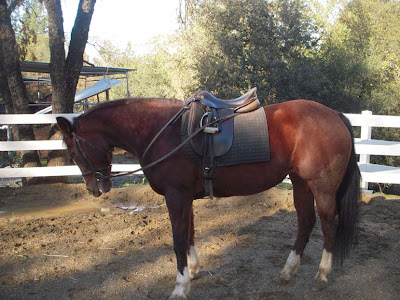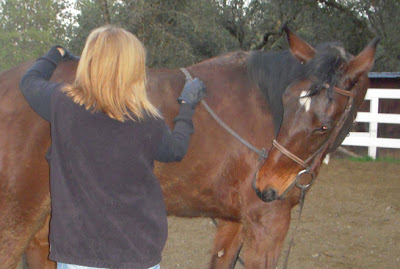
People use non-traditional alternatives to Western medicine all the time: there's massage, chiropractic work, acupressure, acupuncture, and, for the really adventurous, even magnets. As a devotee of acupuncture, who has used this ancient Eastern art to ease back pain as well as severe tendonitis in my knees, I know the benefits of thinking out side the box.
So when our new horse, Scarlett, started showing signs that her "cinchiness" was turning into full-blown attitude, along the lines of I'm-going-to-eat-you-if-you-put-that-saddle-on-my-back, I knew I was dealing with something more than a horse that didn't like the girth tightened.
But when I started thinking about alternative equine measures to help her, I had no idea in which direction I should head. Should I go for chiropractic? Or would massage be better? What was the general opinion about the effectiveness of equine acupuncture? And how do you know which practitioners truly produce results?
Add to all those questions the fact that, with kids in college, I didn't want to fork over an endless stream of cash to make my horse better.
So I did the smart thing: 1) I went to Bay Area Equestrian Network, the fabulous horse resource for Northern California, where I live. There I researched names under alternative therapies. 2) I called my vet to see if they had ever heard of someone I found right in my own backyard.
"Yes," said my vet. "April Battles is the real deal."
So, by God's good graces, I had found April Battles, an equine body worker who combines the best of all worlds--a little chiropractic theory, a little acupressure theory, a little qi (pronounced "chi") theory, a little massage theory, and a lot of intuivtive spirit.
Best of all, during my initial phone conversation with April, she didn't tell me it was going to cost an armload of money to make Scarlett feel better.
"I charge $80 for an hour," explained April, who has helped horses across the nation and in Canada. "And when I leave, you're going to know how to do what I do so you can continue the work and continue helping your horse heal."
Say what? She wasn't going to tell me that she was the only one who could work on Scarlett? It wasn't going to cost me my first-born's college tuition?
In the time between our phone call and our actual appointment, April asked me to go to her YouTube channel,
Holistic Horse Works. There, she has a video showing her evaluating a horse. This allowed me to see how she works.
Even better, she has posted there--FOR FREE--a short video demonstrating moves you can do with your horse to improve mobility, flexibility, balance, and overall comfort.
This "Yoga for Horses" video is just a few minutes long. And it has truly changed Scarlett's outlook on life.
It has now been exactly one week since April Battles first brought her equine body work methods to my little mare. In one week, the changes in Scarlett have been numerous and, wuite frankly, amazing.
--Before April's visit, Scarlett could never stand with all four feet square (an indication, April says, that the horse is out of alignment and probably is in pain, or at least discomfort).
Now Scarlett stands square almost all the time, on her on and when I'm on her.
--Before, saddling meant a glaring contest in which Scarlett stared at me with ears laid flat, waiting for an opportunity to bite me. Her tail would switch back and forth, and the back leg would threaten to kick out. It was truly scary and made me seriously consider selling her for any price. Fifty cents anyone?
Now, I put the saddle on and it is 180 degrees from what I was dealing with before. No tail switching, no threat of biting, no threat of getting kicked. As far as cinching her up, she doesn't even notice. I will admit that she is still a little touchy about taking the saddle off, but this just tells me I have more work to do. but the progress is amazing.
--Before April (and this is the most telling sign that something physical was up with the little mare), Scarlett could not take the left lead. For anything.
Now, left lead is taken easily and cheerfully so! An added bonus is that her overall canter feels much smoother and more balanced.
--Before April, Scarlett's coat was dull and very thick, a fact I attributed to winter. Yesterday, I was astounded to notice that Scarlett's coat has a gleam to it, so much so that she looked like she was basking in the warmth of June, rather than the chilly winds of November. Obviously, what is happening with her in terms of the muculoskeletal aspects is affecting not just her insides, but also her outsides. It's just so evident.
I am now using daily yoga on all four of our horses. I am a firm convert. What I love most is that April (unlike the chiropractor who recently worked on me) did not tell me I had to have her back right away. She didn't tell me I had to have Scarlett seen four times in four days. Quite the opposite, she left me feeling like I could do all this for my horse on my own.
If you want to give a great Christmas gift to the horse person in your life (or the horse) I am recommending everyone buy April's one-hour DVD, "Your Horses are Talking--Are You Listening?"
I am here to tell you, it works!
It's what will be in the stockings of all our Standardbreds this Christmas. And Quarter Horses. And Arabs. And Half-Arabs. And Thoroughbreds. And...

 (PHOTO ABOVE: FAIRLAND FERGUSON OF THE INTERNATIONALLY-ACCLAIMED EQUESTRIAN EXTRAVAGANZA, "CAVALIA" IS FEATURED ON "HORSES IN THE MORNING.")
(PHOTO ABOVE: FAIRLAND FERGUSON OF THE INTERNATIONALLY-ACCLAIMED EQUESTRIAN EXTRAVAGANZA, "CAVALIA" IS FEATURED ON "HORSES IN THE MORNING.")








